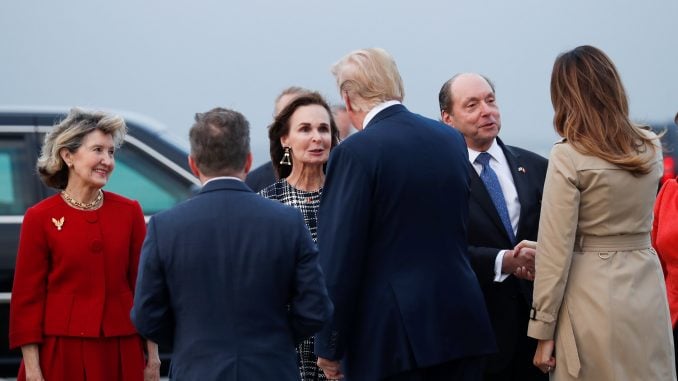
WASHINGTON, D.C. — President Donald Trump is in Brussels on Wednesday morning, kicking off a weeklong trip to Europe that includes a July 11-12 NATO meeting, a visit to Britain and a meeting with Russian President Vladimir Putin. He told reporters before departure that the Putin meeting could be the easiest part of the tour. He repeated his criticism of NATO allies for not spending enough on their defense and pointed to the political tensions in Britain over the government’s Brexit plans.
“So I have NATO, I have the U.K. which is in somewhat turmoil, and I have Putin. Frankly Putin may be the easiest of them all. Who would think?” Trump said.
The two-day NATO meeting ahead of his Putin visit is expected to enshrine reforms that include creating two new military commands aimed at deterring Russia, one of which the U.S. military has agreed to host.
Founded to deter the Soviet threat in 1949, NATO, the North Atlantic Treaty Organization, is based on cooperation with the United States, which provides for Europe’s security with its nuclear and conventional arsenals.
The U.S. president is the de facto leader of the alliance, and Trump has indicated what his message will be this week: other governments must dramatically step up military spending and lower import tariffs.
“I’m going to tell NATO: You’ve got to start paying your bills. The United States is not going to take care of everything,” Trump told a rally last week.
NATO agreed in 2014 that each member state would boost military spending to 2 percent of its gross domestic product by 2024, and cumulative expenditure by Europe and Canada has risen by almost $90 billion since 2015.
But only two-thirds of the 28 allies, excluding the United States, have a realistic plan to hit the 2-percent level in 2024, NATO diplomats say. The United States spent 3.57 percent of GDP on defense in 2017.
“Security is too important to play games with. European countries need to not only fulfil their promises on defense spending, but to demonstrate that they understand the merits of that spending. They must show that they can pay their way.”
Matthieu Borsboom, former vice admiral of the Royal Netherlands Navy
However, European officials say while U.S. defense spending makes up 70 percent of combined allied governments’ military budgets, just 15 percent of U.S. expenditure is spent in Europe on NATO-related defense. Washington pays about 22 percent of the running cost of NATO, including the headquarters and commonly funded equipment such as AWACS surveillance planes.
Wess Mitchell, assistant U.S. secretary of state for European affairs, told diplomats and NATO officials in a recent speech in Brussels that Trump was taking a new approach to problems that have festered for years, such as the Middle East peace process — even if it means going it alone.
“In the actions we take, we are hoping to spur a multilateral response to address some of the world’s toughest challenges,” Mitchell said.
MATTIS WORKS TO BOLSTER NATO MILITARY ALLIANCE
Meanwhile, Defense Secretary Jim Mattis will only play a supporting role to Trump at this week’s NATO summit — an event that by definition is focused on heads of state from the trans-Atlantic alliance.
But Mattis’ small part belies his high standing among NATO allies, which has only risen as they become increasingly off-balance by Trump’s bold moves on trade and Iran and anxious about his outreach to Putin, European diplomats, officials and experts say.
In recent months, it has become clear that Mattis has a limited ability to influence Trump, but by staying above the political fray and avoiding contradicting Trump, has been quietly helping bolster the NATO military alliance over the past 18 months in ways that are too granular to grab much attention in Washington.
“In the Trump administration, he is seen as the most articulate adult in the room,” said one senior European official, who has attended meetings in Europe with Mattis, but did not want to be named.
Mattis, a retired Marine Corps general and former NATO commander, also helped clinch agreement on a plan known as 30-30-30-30. It would require NATO to have 30 land battalions, 30 air fighter squadrons and 30 ships ready to deploy within 30 days of being put on alert.
European allies are increasing their spending on defense, partly because of Trump’s public scolding. Mattis has reinforced that message publicly and privately, to the relief of many European security officials, who long thought their nations’ spending was insufficient.
“The summit should therefore be a moment (for Trump) to take a victory lap,” wrote Derek Chollet, a former Pentagon official under Obama’s administration, who is now at the German Marshall Fund.
TRUMP TO MEET WITH MAY
On Thursday, Trump will visit U.K. where officials there urged Americans in London to “keep a low profile” amid planned protests of the president’s visit.
He will hold talks with Prime Minister Theresa May at her 16th-century manor house, meet Queen Elizabeth at Windsor Castle and attend a black-tie dinner at the home of former World War Two leader Winston Churchill – all outside London.
Asked whether May would stay in power amid ongoing turmoil over Brexit plans, Trump on Tuesday acknowledged the political crisis but said it was up to the British people to decide whether she remains in power.
“That’s up to the people. I get along with her very well, I have a very good relationship,” Trump told reporters at the White House as he departed for a week-long trip to Europe, which includes a visit with May.
May is grappling with a political crisis in London after Brexit Secretary David Davis and her foreign minister, Boris Johnson, resigned over her proposals for a “business-friendly” Brexit, or exit from the European Union.
Trump is expected to return from the Europe tour on July 18.
Reuters News Service contributed to this report.



